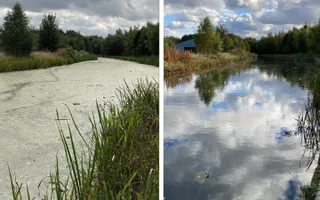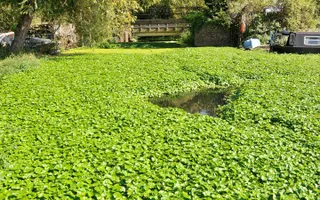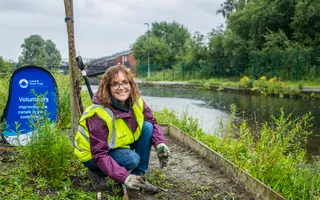Floating pennywort and water fern are both aquatic (or water-based) invasive species, and cause a lot of damage to our canals and rivers. We treat these two weeds in separate ways.
Before and after: eradicating invasive aquatic species
Witness the transformation and see how much floating pennywort and water fern (azolla) has been cleared as part of our Canal & River Invasive Species Eradication Project.

Azolla
Release the weevils!
In September 2021, we introduced North American weevils into our waterways to biologically control water fern. Research by CABI has shown they are a highly effective biocontrol agent and one of the main natural enemies of azolla.
Weevils are small beetles with an elongated snout, and feed off water fern. Deployed at specific sites where azolla is known to be problematic, their attack is so powerful that they have been known to completely eradicate large sections, preventing the need for chemical treatment or other control measures. But, whilst they can cause considerable damage to sizeable quantities of water fern, they won't harm other plants.
These small yet mighty beetles can be bred in large numbers for bulk release.
Daw End Canal, Park Lime Pits Local Nature Reserve
Historically used to carry limestone to the furnaces of the Black Country and surrounding areas, the Daw End Branch Canal is one of the most rural of the Birmingham Canal Navigations.
A total of 500+ weevils were released at this site. The sliding image below shows the huge impact they had in just four weeks. It was one of the most successful sites of our biocontrol programme.
Walsall Canal - Birchills site 1
The Walsall Canal runs through the industrial centre of the Black Country. Along this waterway, we released weevils in two areas.
Site 1 is located at Birchills Junction of the Walsall and Wyrley & Essington Canals, and is the northernmost site on the waterway for our biocontrol programme.
Here, we released a total of 500+ weevils. Below shows a dramatic reduction in water fern in the space of five weeks.
Walsall Canal - Birchills site 2
Walsall Canal site 2 is located at Railway Aqueduct 6, Birchills.
Here, a total of 1,000+ weevils were released, which successfully rid the entire area of azolla in eight weeks.
Floating pennywort
Bringing in the heavies
Floating pennywort has the ability to grow from even the most minuscule of fragments left in the water, which makes its removal incredibly difficult.
Historically, the best tried and tested method of lifting sizeable quantities out of our waterways is through the use of large machinery.
Cannock Extension Canal
The Cannock Extension Canal forms part of the Northern Birmingham Canal Navigations. It is one of our 63 Sites of Special Scientific Interest (SSSI), as well as a Special Area of Conservation (SAC) and a Special Protected Area (SPA).
With floating pennywort identified as a threat to the nationally scarce floating water-plantain found in the area, contractors were tasked to remove as much as possible using a Truxor craft.
Space to store the pennywort on our land nearby allowed any insects or vertebrates accidentally lifted out to return to the canal. For the smaller, more isolated patches of floating pennywort, targeted herbicide spraying took place after the machinery had been through.
Worcester & Birmingham Canal, New Wharf arm
This part of the Worcester & Birmingham Canal was identified as a problematic floating pennywort site within the West Midlands. In recent years the floating pennywort has been able to adapt to the local conditions and continue to grow, making it even harder to control.
Here, a conver boat and weed basket attachment was used to remove and harvest the plant. A hopper was used alongside the conver boat to temporarily store gathered floating pennywort as the vessel moved along the area.
Fens Branch Canal
This section of Fens Branch Canal (Stourbridge Canal) has suffered from lack of water flow over a number of years due to an abundance of floating pennywort. If left untreated, this can lead to longer term issues with water supply and quality.
Similar to the works on the Worcester & Birmingham canal, a conver boat was used to upheave large quantities of the plant. To treat remaining fragments still in the water and prevent regrowth, a herbicide was used.
Last Edited: 24 April 2025


Stay connected
Sign up to our newsletter and discover how we protect canals and help nature thrive



